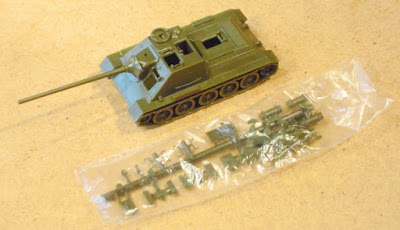I had several good reasons to go to CAVALIER this year, foremost amongst which was to meet and chat with David Crook who writes the 'A Wargaming Odyssey' blog.
As usual the Tunbridge Wells Wargames Society organised the show, and the venue was the Angel Centre in the centre of Tonbridge, Kent. Parking was not too much of a problem, and I was inside the venue by just after 10.00am.
There were already quite a few people inside, and I decided to start with a quick look around the main hall.
I then made my way towards the smaller hall where the 'bring-and-buy' and several participation wargames were taking place. To get there I had to pass through a lobby area ...
... which is where I met up with David Crook. We were able to exchange a few items that were had planned to swap (a box of books for two boxes of Hexon II blue hexes ... a very fair exchange in my opinion!) and to have a quick chat about his plans for a Madasahatta-type campaign set in the southern part of the Arabian peninsula.
Whilst we were there we were joined by Alan Abbey (the creator of the BLOOD, BILGE AND IRON BALLS naval wargame rules and the organiser of the annual 'Broadside' wargames show that take place in Sittingbourne), who has a new set of American War of Independence rules in the final stages of development.
I then paid a visit to the smaller hall ...
... and spent some time looking at the various games that were in progress.
SEEMS (South East Essex Military Society)
Staines Wargamers: HOTT (Hordes of the Things) demonstration/participation games
Maidstone Wargames Society: Road to Homs 1982
North London Wargames Group: Monoontour 1569
Gravesend Gamers Guild: Warmachine
Southend Wargames Club: Helmand Rescue
Tonbridge Wargames Club: Chickamauga Day 2
This game used the latest version of Richard Borg's BATTLE CRY rules, Hexon II hexed terrain tiles, and 10mm-scale figures.
In a small room adjoining the smaller hall was the ...
Society of Ancients: Battle of Trebia 218 BC
... game being run - as usual - by Professor Phil Sabin and ...
The League of Gentlemen Anti-Alchemists: Rommel: Our part in his downfall
On my return to the main hall I met up with a group of well-known wargamers and bloggers. (Left to right: David Crook, Postie, Clint, Big Lee, Henry Hyde, and Ray Rousell.)
Inside the main hall there were also several wargames in progress.
Friday Night Fire Fight: Zulu! 1879
Peter Pig: Hammerin' Iron
Hailsham Wargames Club: Malplaquet 1709
This wargame was staged using hundreds of Les Higgins 20mm-scale figures ... and was very impressive!
Deal Wargames Society: Prison Break! Los Banos, the Philippines, 1945
Crawley War Games Club: Trench Raid
This was - as usual - a great little wargames show.
As usual the Tunbridge Wells Wargames Society organised the show, and the venue was the Angel Centre in the centre of Tonbridge, Kent. Parking was not too much of a problem, and I was inside the venue by just after 10.00am.
There were already quite a few people inside, and I decided to start with a quick look around the main hall.
I then made my way towards the smaller hall where the 'bring-and-buy' and several participation wargames were taking place. To get there I had to pass through a lobby area ...
... which is where I met up with David Crook. We were able to exchange a few items that were had planned to swap (a box of books for two boxes of Hexon II blue hexes ... a very fair exchange in my opinion!) and to have a quick chat about his plans for a Madasahatta-type campaign set in the southern part of the Arabian peninsula.
Whilst we were there we were joined by Alan Abbey (the creator of the BLOOD, BILGE AND IRON BALLS naval wargame rules and the organiser of the annual 'Broadside' wargames show that take place in Sittingbourne), who has a new set of American War of Independence rules in the final stages of development.
I then paid a visit to the smaller hall ...
... and spent some time looking at the various games that were in progress.
SEEMS (South East Essex Military Society)
Staines Wargamers: HOTT (Hordes of the Things) demonstration/participation games
Maidstone Wargames Society: Road to Homs 1982
North London Wargames Group: Monoontour 1569
Gravesend Gamers Guild: Warmachine
Southend Wargames Club: Helmand Rescue
Tonbridge Wargames Club: Chickamauga Day 2
This game used the latest version of Richard Borg's BATTLE CRY rules, Hexon II hexed terrain tiles, and 10mm-scale figures.
In a small room adjoining the smaller hall was the ...
Society of Ancients: Battle of Trebia 218 BC
... game being run - as usual - by Professor Phil Sabin and ...
The League of Gentlemen Anti-Alchemists: Rommel: Our part in his downfall
On my return to the main hall I met up with a group of well-known wargamers and bloggers. (Left to right: David Crook, Postie, Clint, Big Lee, Henry Hyde, and Ray Rousell.)
Inside the main hall there were also several wargames in progress.
Friday Night Fire Fight: Zulu! 1879
Peter Pig: Hammerin' Iron
Hailsham Wargames Club: Malplaquet 1709
This wargame was staged using hundreds of Les Higgins 20mm-scale figures ... and was very impressive!
Deal Wargames Society: Prison Break! Los Banos, the Philippines, 1945
Crawley War Games Club: Trench Raid
This was - as usual - a great little wargames show.






















































.jpeg)

















.jpeg)












